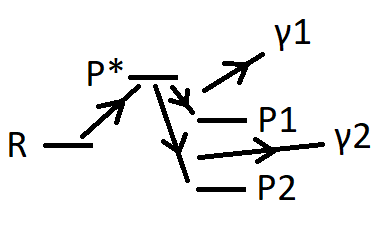Someone posed an interesting question to me the other day: is all production of light accompanied by the generation of heat? I have found that the question as posed invites vague answers, so I thought I would restrict the question to the case of chemiluminescence and sharpen the language to the following:
Is there an example of a spontaneously occuring endothermic chemical reaction which generates light as one of the (possibly many) products?
Assume for the sake of specificity that the reaction occurs at constant temperature and volume. Conceptually, I am envisioning the following energy diagram:
where the reaction begins with a system consisting purely of reactants $R$. These reactants are excited to a metastable product state $P^*$, with the energy for the excitation coming from the temperature bath. The meta stable state relaxes to the final product state $P$, emitting a photon $\gamma$ in the process. We then would have an instance of a process where a system simultaneously produces light and absorbs heat from its surroundings. Note that this is this case whether the energy of the products (neglecting the photon energy) is greater than the reactants (i.e. $P1$) or lower (i.e. $P2$), since in either case the combined energy of $Pn + \gamma n,\,n=1,2$ is greater than $R$.
So I would like to ask if there is a good example which comes to mind of such a reaction, either for final products $(P1, \gamma 1)$ or $(P2, \gamma 2)$?



